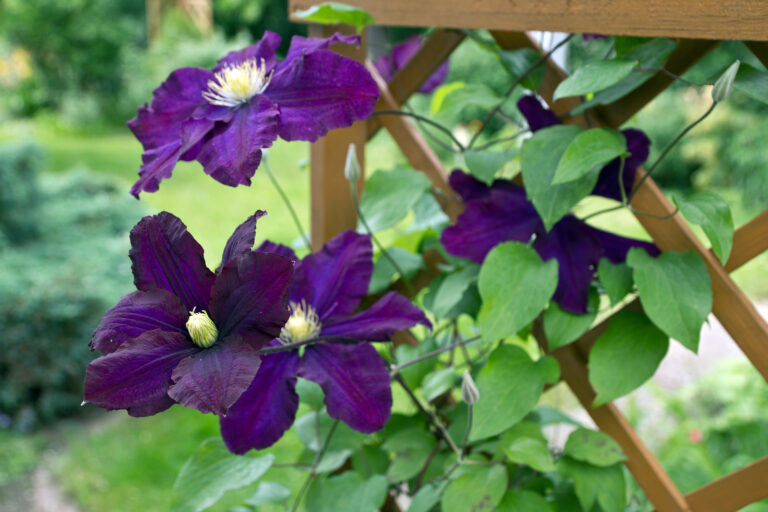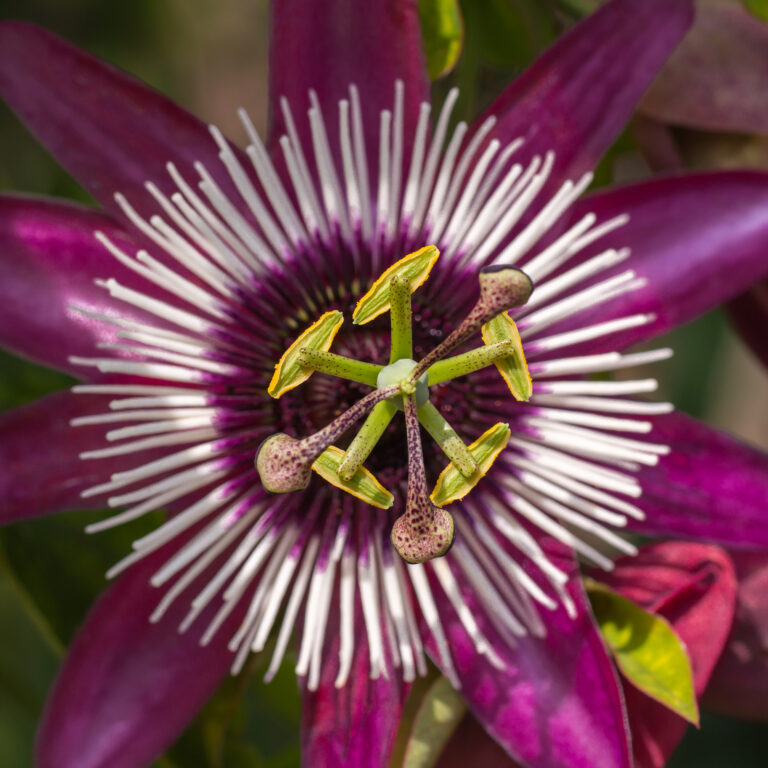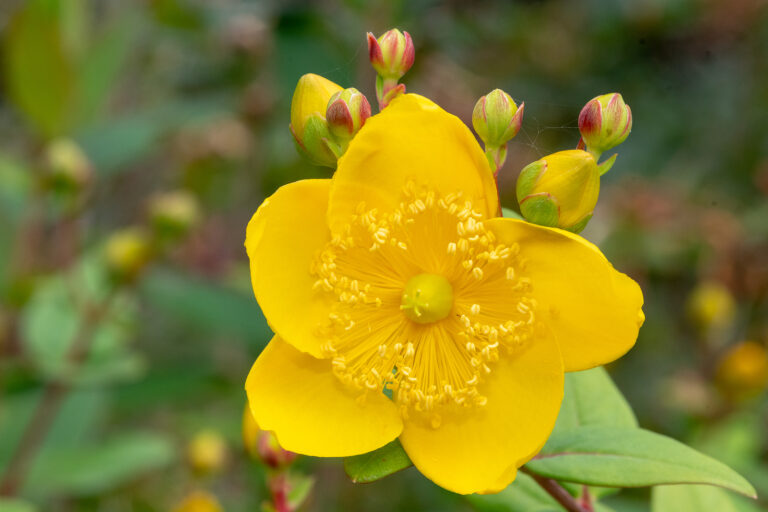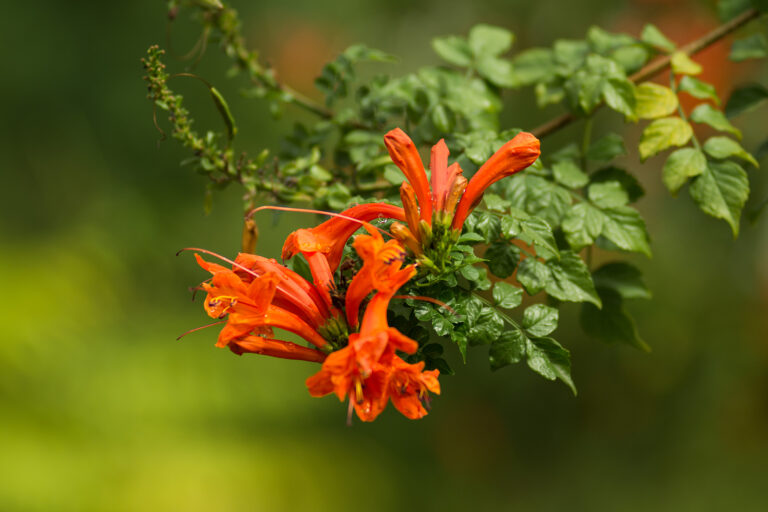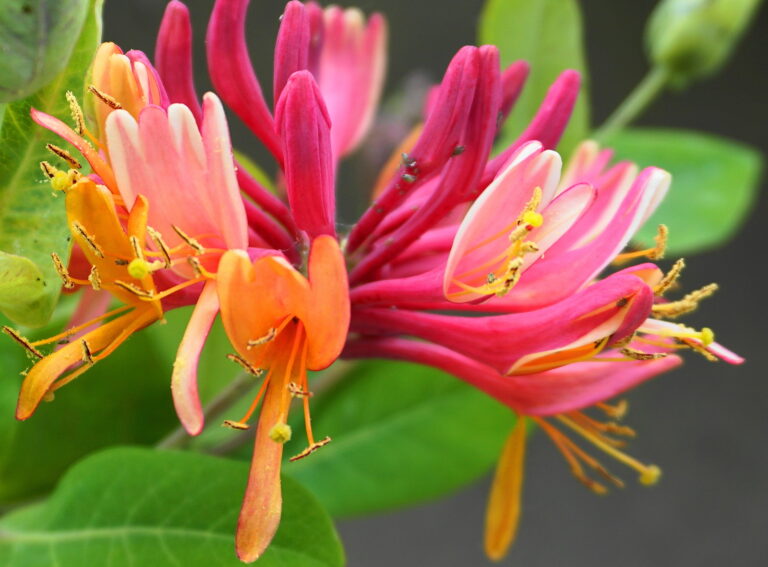How to Grow and Care for Clematis
Clematis are evergreen or deciduous climbers grown for their attractive and often spectacular flowers.
There are more than 200 species of clematis and hundreds of cultivars. Most widely planted are the summer-blooming hybrids that bear showy, single, semi-double, or double blooms ranging from 4 to 8 inches (10-20cm) across. Some clematis varieties have flowers that are bell- or tulip-shaped, and there are varieties with small starry blooms similar to dogwood blossoms.
Besides summer-blooming clematis, there are also spring- and fall-blooming types. Some clematis bloom in two seasons, summer and fall.
Most clematis are prolific bloomers, with this condition: the larger the size of the flowers a cultivar bears, the fewer the number of blooms. No matter the size or number of blooms, clematis always stands out in a landscape.
Clematis flowers lack true petals–the petals are actually petal-like sepals. Flower colors include violet, purple-blue, pink, crimson, mauve, white, and even yellow. Some have showy anthers at the center of the bloom. Blooms can appear singly or in panicles or cymes.
Clematis flowers are followed by feathery, silvery, seed heads that are showy in their own right. Leaves can be either undivided or pinnately divided depending on variety.
Clematis require a trellis or other support. Vines climb by attaching themselves to supports with twining leafstalks. They cannot attache themsleves to bare fences or wall or wrap themselves around posts or large supports. They do best when trained to a trellis or lattice with soft string.
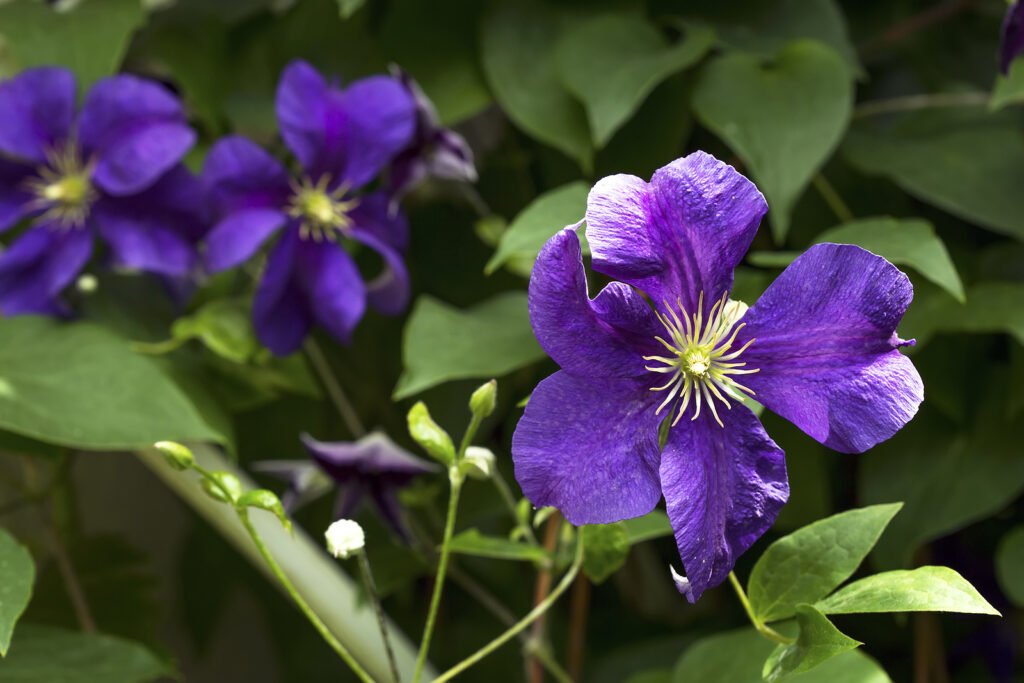
Get to know Clematis
- Plant type: Deciduous or evergreen summer- or fall-blooming vine
- Growing Zones and range: Zones 3 to 9 depending on variety
- Hardiness: Half-hardy to tender depending on the variety or cultivar
- Height and width: 6 to 30 feet (1.8-9.1m) long
- Foliage: Simple green leaves with ragged edges can be arranged palmate or pinnate
- Flowers: Several flower forms from single to double from four petals to multi-petal doubles
- Flower colors: White, pink, red, blue lavender, or purple
- Bloom time: Summer to fall
- Uses: Climbing species can be trained to a wall, arbor, trellis or pergola; some can be grown as large shrubs
- Common name: Clematis
- Botanical name: Clematis spp.
- Family: Ranunculaceae
- Origin: Various places in both the Northern and Southern Hemisphere
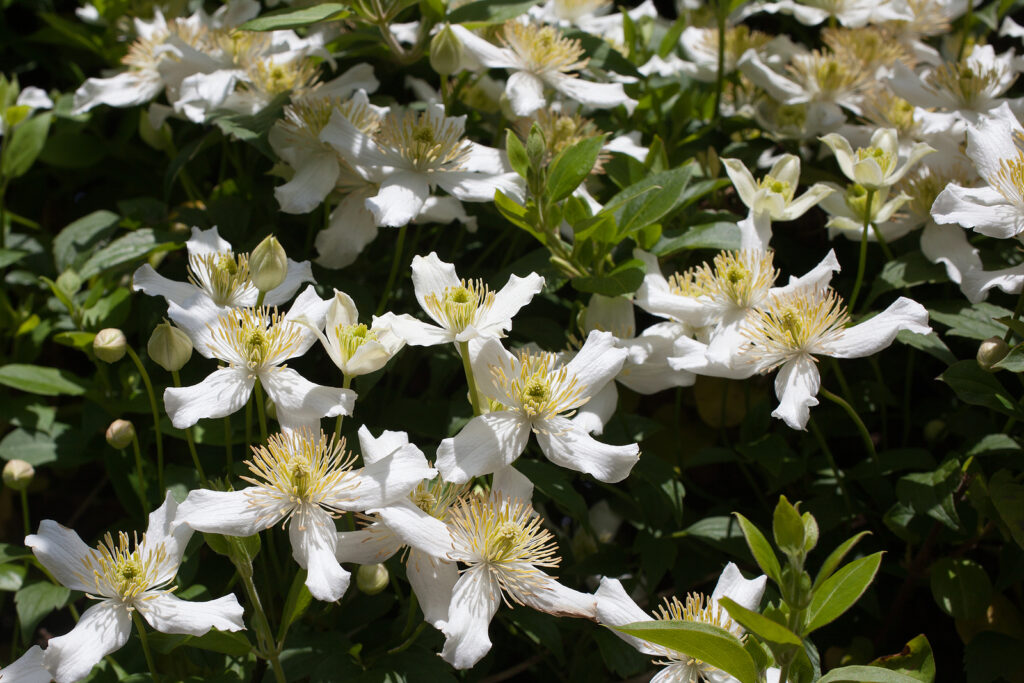
Where to plant Clematis
- Plant clematis in full sun to part shade depending on the variety. Clematis grows best when roots are shaded–“heads in the sun, feet in the shade.” A location with dappled or partial shade during the hottest part of the day is best.
- Grow clematis in humus-rich, moisture-retentive, and well-drained soil.
- Clematis prefers a soil pH of about 6.5.
Clematis uses and companions
- Use climbing species to clothes a wall, arbor, trellis, or pergola; they can be grown over small shrubs and trees.
- Use herbaceous species in a mixed or herbaceous border.
- Good garden companions for Clematis include Anemone hybrida, Astilbe, Chelone, Dictamus albus, Hosta, Iris (Siberian).
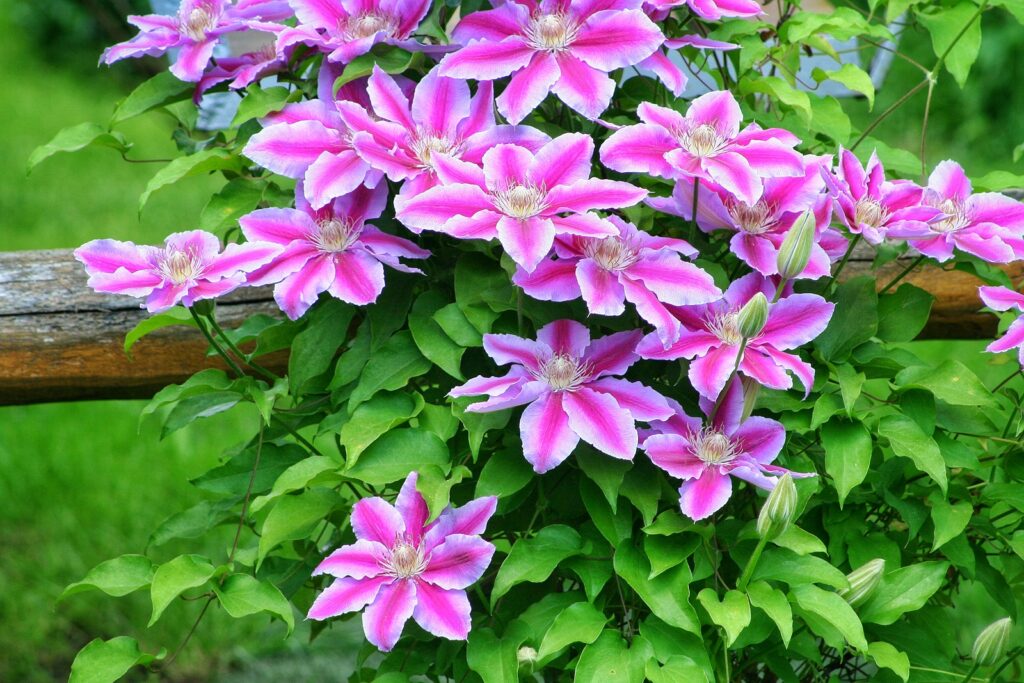
When to plant Clematis
- Set clematis in the garden in spring after all danger of frost has passed.
Planting and spacing Clematis
- Space clematis 10 feet or more apart.
- When planting, set the crown 2-3 inches below the soil surface to encourage strong roots and growth.
- Work aged compost into the soil at planting time.
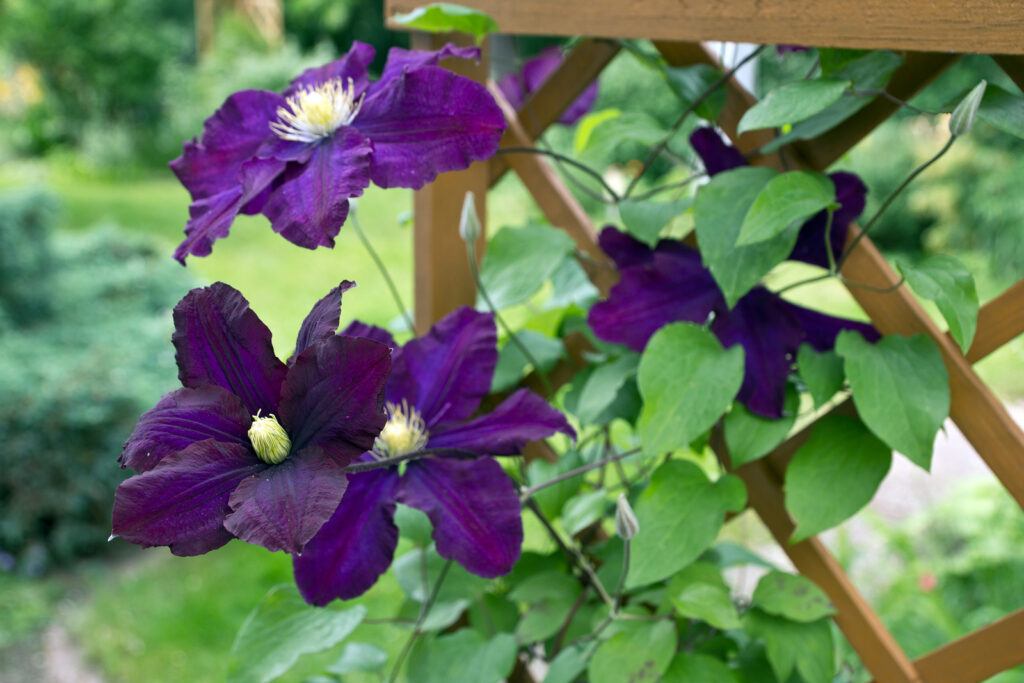
How to water and feed Clematis
- Clematis needs ample water; keep the soil evenly moist.
- Water deeply during dry weather.
- Fertilize clematis every spring by working a slow-release balanced fertilizer into the soil.
Clematis care
- Mulch around clematis to keep roots cool and conserve soil moisture.
- When clematis is 2 feet (.61cm) tall, cut the plant back to 18 inches to promote branching.
- Provide sturdy support at planting time. Clematis can not attach themselves to bare fences or walls or wrap around large supports; tie clematis to trellises with garden twine or soft string.
- Clematis that bloom in early summer, or those that bloom nearly all year round should be pruned in early spring when new growth is apparent; prune the vine back to 8 inches and a pair of well-formed leaf buds.
- Clematis that blooms in fall should be pruned in early spring to about 1 foot high.
- Spring blooming types flower on the previous year’s growth; prune after flowering to remove broken, dead, or diseased wood.
- Summer and fall bloomers flower on the current year’s new growth; prune these in late winter or early spring.
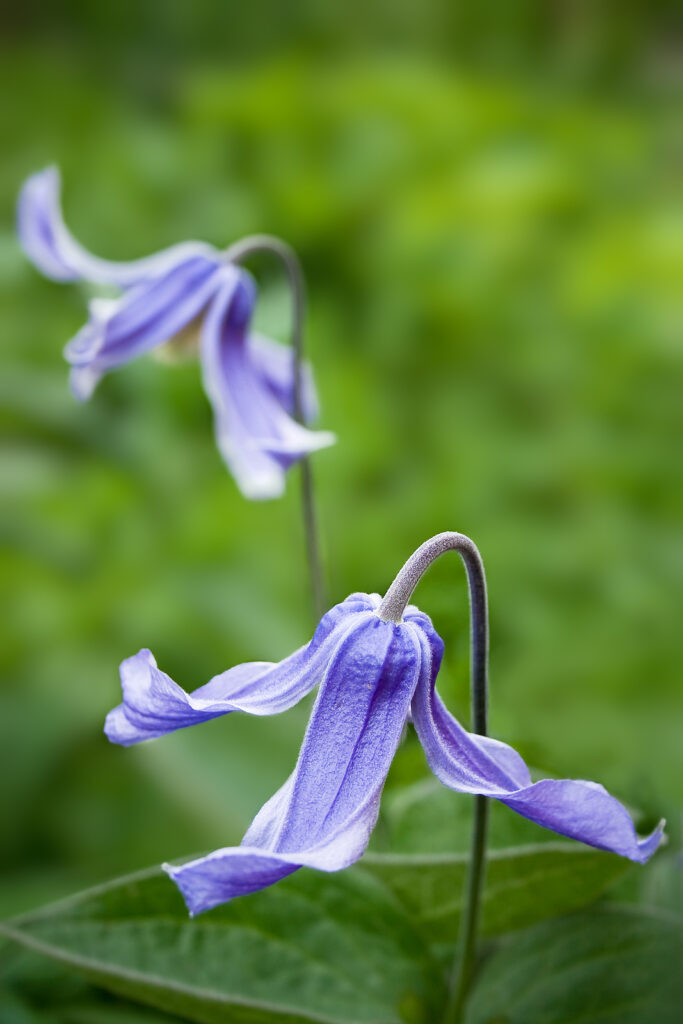
Clematis propagation
- Propagate clematis by layering in early spring or by cuttings taken from new shoots at the base of the plant in spring.
- Take cuttings in spring or early summer. Layer vines in spring.
- Clematis seeds can take up to 3 years to germinate; some may germinate in 6 months to a year. (1) Collect ripe seeds in the fall and sow in a sterile seed starting mix, covering seeds with a thin layer of sand. (2) Place the container into a zip lock polyethylene bag and place it outside in a shady spot (or a refrigerator) for several months during the winter. (3) Place the covered container in a warm location out of direct sunlight and wait for your first seedling.

Pruning Clematis
- Clematis hybrids are often the result of complex crosses. Some hybrids may bloom on old wood, meaning the previous season’s growth, and some bloom on the current season’s growth. To know how to determine how to prune an unidentified clematis, watch closely for a season to see when it blooms, whether the booms are produced on old or new growth
- Early-blooming clematis bloom on old wood from early spring to early summer. Prune early-blooming clematis immediately after flowering by removing dead or damaged growth and cutting back shoots to shape the plants. Prune these plants every year to encourage blooming.
- Early large-flowered hybrids overlap bloom time with the early-blooming clematis group, from late spring into early summer, and often re-bloom in mid-to-late summer. The first blooms are produced on old wood; hybrids that later rebloom produce flowers on new wood at the tips of the current year’s growth. Plants in this group generally do not need heavy annual pruning to bloom well. In spring before growth begins, prune out all dead or damaged growth. The cut stems back to a strong set of buds at 2 or 4 feet (.6-1.2m) above the ground.
- Late-flowering clematis includes both species and large-flowered hybrids that bloom from summer to early fall. Prune clematis in this group annually in early spring before new growth begins; cut them back to just above a healthy pair of buds 8 to 12 inches (20-30cm) above the ground. Prune Clematis inregrifolia similarly,

Clematis species and hybrids
Clematis can be divided into three groups by bloom season: (1) early-blooming clematis, (2) early large-flowered hybrids, and (3) late-flowering clematis
Early large-flowered hybrids
- Clematis alpina, alpine clematis. Grows 8 to 12 feet (2.4-3.6m); flowers have four-spreading, pointed, petal-like sepals; flowers may be blue, white, purple, pink, or red. Varieties include pale pink ‘Willy’, dark blue ‘Helsingborg’, and lavender-blue ‘Pamela Jackman.’
- C. armandii, evergreen clematis. Fast-growing to 20 fee (6m)t, glossy dark green leaves, white fragrant flowers to 2.5 inches wide; ‘Hendersoni Rubra’ has light pink flowers.
- C. chrysocoma. Grows 6 to 8 feet (1.8-2.4m); long-stalked white, shaded pink flowers to 2 inches wide in clusters; requires shade.
- C. dioscoreifolia (C. terniflora, C. paniculata, C. maximowicziana), sweet autumn clematis. Grows to 6 feet (1.8m); billowy masses of 1 inch wide creamy white, fragrant flowers; a good choice for a privacy screen.
- C. durandii. Hybrid between C. jackmanii and C. integrifolia, nonclimbing grows to 6 feet; violet-blue flowers.
- C. forida ‘Sieboldii’. Grows 8 to 12 feet (2.4-3.6m) with purple petal-like stamens; ‘Alba Pena’ has double greenish-white flowers.
- C. heracleifolia, tube clematis. Dense clustered of 1-inch medium to deep blue, fragrant flowers.
- C. integrifola, herbaceous clematis. Grows to 3 feet (.9m); nodding, urn-shaped 1.5 inch long blue flowers; ‘Hendersonii’ has larger flowers.
- C. jackmanii, series of hybrids between forms of C. lanuginosa and C. viticella. Rapid growth to 10 feet; best known of the older large-flowered hybrids simply known a C. jackmanii; a profusion of 4 to 5-inch purple flowers. Newer hybrids have large flowers such as ‘Comtesse de Bouchard’ has silvery rose-pink flowers; purplish-red ‘Mme. Edouard Andre’
- C. lanuginosa. Grows 6 to 9 feet (1.8-2.7m) and produces 6-inch lilac to white flowers’ ‘Candida’ has white 8-inch flowers.
Late-flowering hybrids
- Clematis macropetala, downy clematis. Grows 6 to 10 feet bear lavender to powder blue 4 in flowers; ‘Markham Pink’ has lavender-pink flowers.
- C. montana, anemone clematis. Grows to 20 feet (6m); massive display of 2-inch anemone-like flowers open white then turn pink.
- C. orientalis, Oriental clematis. Grows 20 to 25 feet, (6-7.6m) and bears 3-inch wide bell-shaped yellow flowers; ‘Bill MacKenzie’ is a popular cultivar.
- C. recta, ground clematis. Not a climber grows 4 to 5 feet (1.2-1.5m)with a profusion of fragrant white flowers; a sprawling version of C. dioscoreifooia.
- C. tangutica, golden clematis. Grows 10 to 15 feet (3-4.5m) with bright yellow 2 to 4-inch, nodding, lantern-shaped flowers in profusion.
- C. terniflora, Sweet autumn clematis. See C. dioscoreifolia.
- C. texensis, Texas clematis also called scarlet clematis. Fast-growing from 6 to 10 feet (1.8-3m), bears bright scarlet urn-shaped flowers; the hybrid ‘Duchess of Albany’ has bright pink flowers.
- C. viticella, Italian clematis. Grows 12 to 15 feet (3.6-4.5m), purple or rose-purple 2-inch flowers; variety ‘Mme. Julia Correvon’ is rosy red, ‘Polish Spirit’ is deep purple-blue with a red center.
Hybrids by color
- White: ‘Henryi’ and ‘Candida’ standard flowers; ‘Marie Boisselot’ and ‘Mme. Le Coultre’ large, flat, round flowers; ‘Gillian Blades’ extra-large, star-shaped flowers.
- Pink: ‘Comtesse de Bouchaud’ standard pink flowers; ‘Charissima’ veined pink flowers; ‘Hagley Hybrid’ (‘Pink Chiffon’), shell pink with pointed sepals; ‘Lincoln Star’ pink with paler edges.
- Red: ‘Mme. Edouard Andre’, ‘Ernest Markham’ and ‘Red Cardinal standard flowers; ‘Ville de Lyon’ full, rounded, velvety flowers; ‘Niobe’ is the best red.
- Blue-violet: Mid-blue ‘Ramona’; ‘Edo Murasaki’ deep purple; ‘General Sikorski’ large with faint red bar; ‘Lady Betty Balfour’ dark blue; ‘Mrs. Cholmondeley, sky blue; ‘Piccadilly’ purplish-blue; ‘Prince Philip’ large purplish-blue with ruffled edges; ‘Willi Goodwin’ lavender to sky blue.
- Purple: Classic C. jackmanii is the most popular; ‘Purpureus Superba’ also called ‘Jackmanii Superba’ is larger than C. jackmanii; ‘Gypsy Queen’ deepest purple; ‘Mrs. M. Thompson’s deep bluish-purple with red bar; ‘Richard Pennell’ rosy purple.
- Bicolor: ‘Nelly Moser’ purplish-pink with reddish center bar, very popular; ‘Carnaby’ shite with red bar; ‘Dr. Ruppel’ pink with a red bar.
- Double: Fully double, roselike blooms: ‘Belle of Woking’ silvery blue; ‘Duchess of Edinburg’ white; ‘Mrs. P.T. James deep blue; ‘Teshio’ lavender; ‘Vyvyan Pennell’ deep blue with the lavender-blue center.
Clematis frequently asked questions
Q: What growing situation do clematis like?
A: Plant clematis so that the roots are in a cool, shady spot but the upper growth is in full sun (plant near a shrub, for instance). The soil should be light, organic, and well-drained but not constantly wet. Use abundant mulch to protect the soil and roots. Clematis grows well in alkaline soil.
Q: What care does a mature clematis need?
A: You need to know if your clematis is an early spring bloomer or a summer bloomer. Spring-blooming clematis blooms on old wood and should be pruned lightly. Summer blooming clematis can be pruned back to the ground in early spring. It will start anew from its base in spring.


